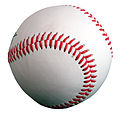Bat-and-ball games
Baseball is a bat-and-ball sport played between two teams of nine players each. The goal is to score runs by hitting a thrown ball with a bat and touching a series of four bases arranged at the corners of a ninety-foot square, or diamond. Players on one team (the batting team) take turns hitting against the pitcher of the other team (the fielding team), which tries to stop them from scoring runs by getting hitters out in any of several ways. A player on the batting team can stop at any of the bases and later advance via a teammate's hit or other means. The teams switch between batting and fielding whenever the fielding team records three outs. One turn at bat for each team constitutes an inning; nine innings make up a professional game. The team with the most runs at the end of the game wins. Evolving from older bat-and-ball games, an early form of baseball was being played in England by the mid-eighteenth century. This game and the related rounders were brought by British and Irish immigrants to North America, where the modern version of baseball developed. By the late nineteenth century, baseball was widely recognized as the national sport of the United States. Baseball on the professional, amateur, and youth levels is now popular in North America, parts of Central and South America and the Caribbean, and parts of East Asia. The game is sometimes referred to as hardball, in contrast to the derivative game of softball. In North America, professional Major League Baseball (MLB) teams are divided into the National League (NL) and American League (AL). Each league has three divisions: East, West, and Central. Every year, the champion of Major League Baseball is determined by playoffs that culminate in the World Series. Five teams make the playoffs from each league: the three regular season division winners, plus two wild card teams. Baseball is the leading team sport in both Japan and Cuba, and the top level of play is similarly

split between two leagues: Japan's Central League and Pacific League; Cuba's West League and East League. In the National and Central leagues, the pitcher is required to bat, per the traditional rules. In the American, Pacific, and both Cuban leagues, there is a tenth player, a designated hitter, who bats for the pitcher. Each top-level team has a farm system of one or more minor league teams. These teams allow younger players to develop as they gain on-field experience against opponents with similar levels of skill. Bat-and-ball games (or safe haven games to avoid confusion with the club games like golf and hockey) are field games played by two opposing teams. The teams alternate between "batting" roles, sometimes called "in at bat" and "out in the field", or simply in and out. The fielding team defends, so only the batting team may score, but they have equal chances in both roles. The game is counted rather than timed. A player on the fielding team puts the ball in play with a delivery whose restriction depends on the game. A player on the batting team attempts to strike the delivered ball, commonly with a "bat", which is a club governed by the rules of the game. After striking the ball, the batter may become a runner trying to reach a safe haven or "base". While in contact with a base, the runner is safe from the fielding team and in a position to score runs. Leaving a safe haven places the runner in danger of being put out. The teams switch roles when the fielding team puts the batting team out, which varies by game. In modern baseball the fielders put three players out; in cricket they retire all players but one. Some games permit multiple runners and some have multiple bases to run in sequence. Batting may occur, and running begin, at one of the bases. The movement between those "safe havens" is governed by the rules of the particular game. Globally, cricket and baseball are the two most popular games in the family.